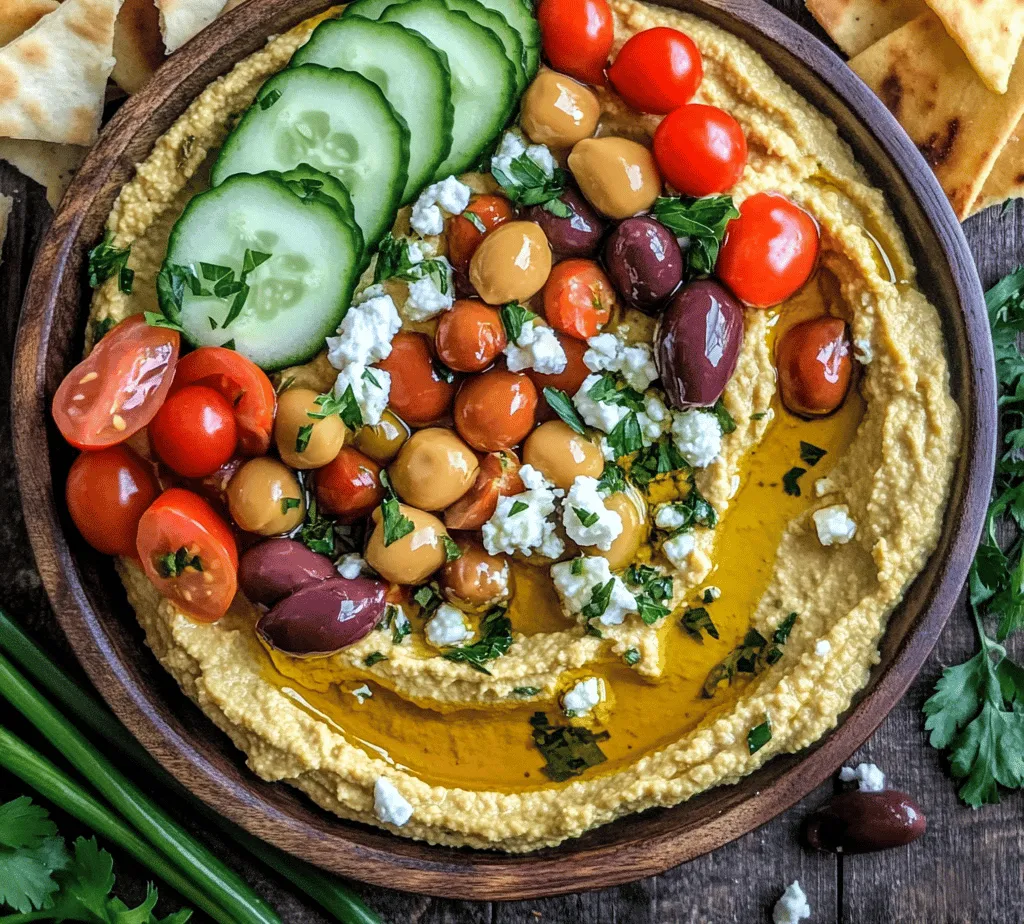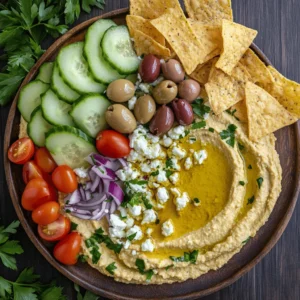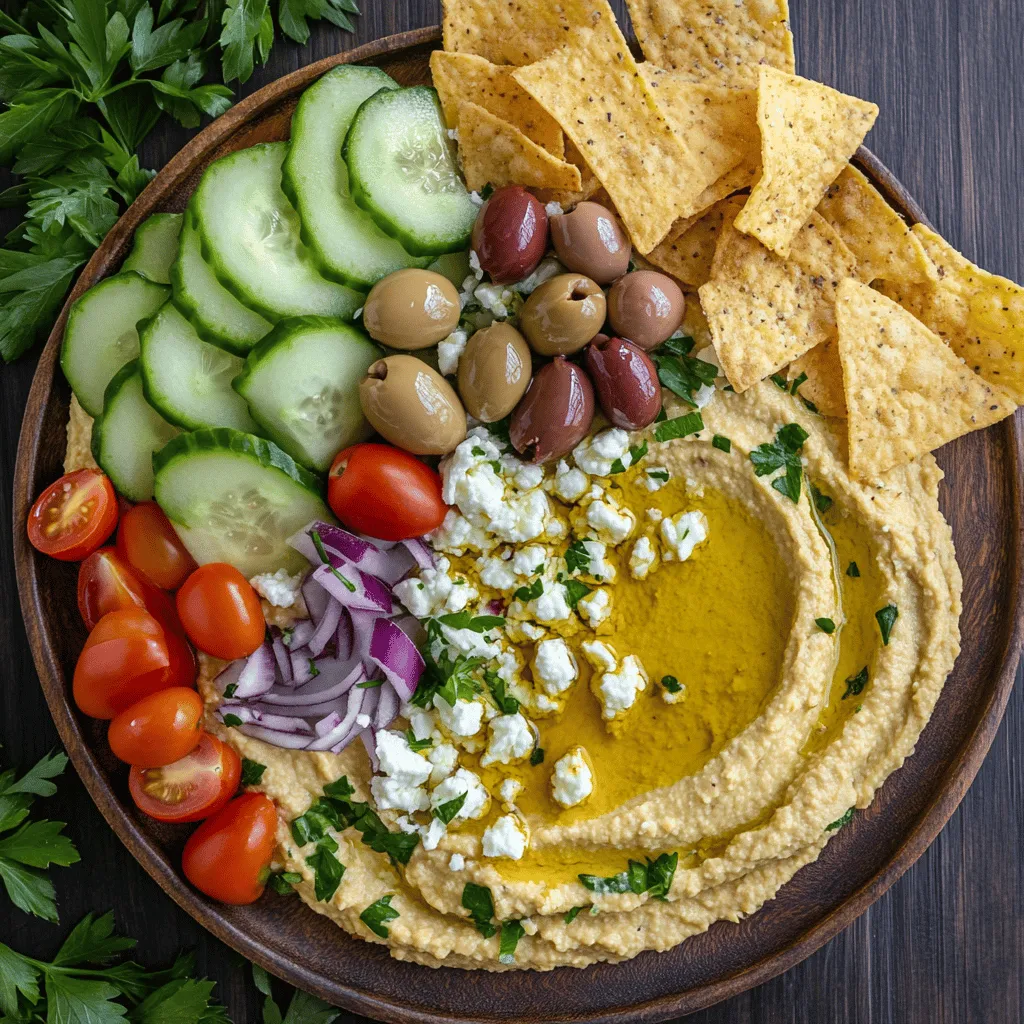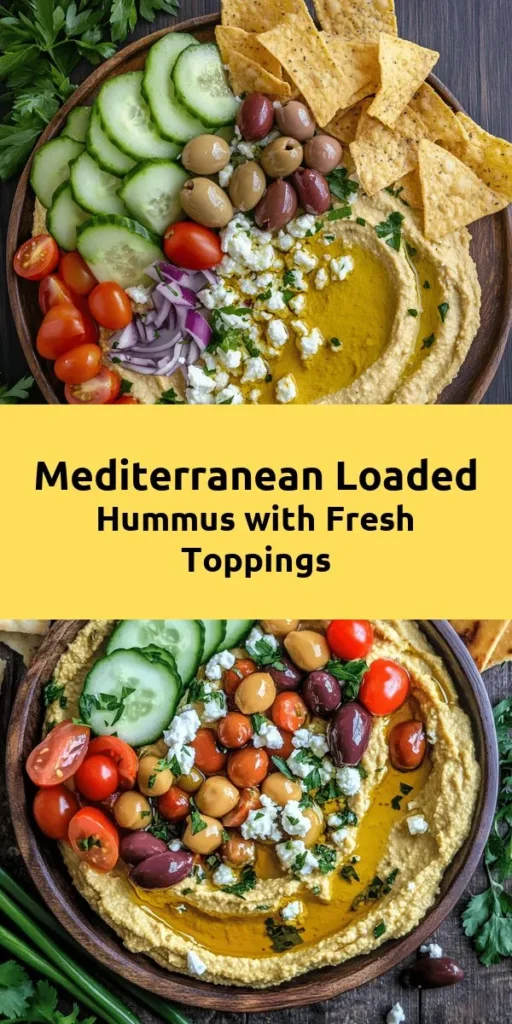Explore the delightful world of Mediterranean cuisine with our Greek Style Loaded Hummus recipe. This vibrant dish combines the rich, creamy texture of traditional hummus with fresh, colorful toppings that embody the flavors of Greece. Loaded with fresh vegetables, olives, and feta cheese, this hummus not only serves as a delicious appetizer but also as a nutritious snack that captures the essence of Mediterranean living. In this article, we will guide you through the process of making this delectable dish, breaking down every step and ingredient while diving into the cultural significance and health benefits of each component.
Understanding Hummus: A Mediterranean Staple
The History of Hummus
Hummus, a dish that has gained immense popularity worldwide, has a rich history that dates back centuries. Its origins are often debated, with claims stemming from various Middle Eastern and Mediterranean cultures, including Lebanon, Israel, and Palestine. The word “hummus” itself simply means “chickpeas” in Arabic, highlighting the primary ingredient of this beloved dip.
Historically, hummus has been a staple in the Mediterranean diet, particularly due to its accessibility and nutritional value. Traditionally made with chickpeas, tahini, garlic, lemon juice, and olive oil, hummus has evolved to include a variety of flavors and ingredients, reflecting the local tastes and preferences of different regions. In Greece, for example, hummus is often enhanced with local herbs and served alongside pita bread or fresh vegetables, making it a versatile dish suitable for any meal or occasion.
Nutritional Benefits of Hummus
Beyond its delightful flavor, hummus is celebrated for its impressive nutritional profile. This dish is an excellent source of plant-based protein, making it a favored choice among vegetarians and vegans. Chickpeas, the primary ingredient in hummus, are rich in protein, containing about 15 grams per cooked cup. They are also high in dietary fiber, which aids in digestion and promotes a feeling of fullness, making hummus a satisfying snack.
The inclusion of tahini, made from ground sesame seeds, adds healthy fats and additional protein to the mix. Tahini is also packed with vitamins and minerals, including calcium, iron, and magnesium. Furthermore, the olive oil used in hummus is a source of monounsaturated fats, which are known to be heart-healthy. When combined with fresh produce like cucumbers, tomatoes, and herbs, hummus becomes a nutrient-dense option that contributes to overall health and well-being. It is a dish that not only pleases the palate but also nourishes the body.
Ingredients Breakdown for Greek Style Loaded Hummus
To create the perfect Greek Style Loaded Hummus, it’s crucial to understand the role of each ingredient. Here’s a breakdown of what you’ll need:
Essential Ingredients
– Chickpeas: The heart of hummus, chickpeas provide a creamy texture and a substantial amount of protein. High in fiber, they help stabilize blood sugar levels and support digestive health. For the best results, you can use canned chickpeas for convenience or soak and cook dried chickpeas for a more authentic flavor.
– Tahini: This sesame seed paste adds a rich, nutty flavor to hummus. Not only does tahini enhance the creaminess of the dip, but it also contributes calcium and healthy fats, making it an essential component of this recipe. When choosing tahini, opt for a high-quality product that is made from pure sesame seeds for the best taste and nutritional benefits.
– Olive Oil: Extra virgin olive oil is a staple in Greek cooking and is key to achieving the smooth texture of hummus. It’s important to use high-quality oil, as it adds depth of flavor and healthy fats to the dish. The rich, fruity notes of the olive oil will elevate your hummus to new heights.
– Fresh Produce: Incorporating fresh ingredients like cucumber, tomatoes, and parsley not only enhances the flavor but also boosts the nutritional value of the dish. Cucumbers add a refreshing crunch, tomatoes contribute acidity and sweetness, while parsley adds a burst of fresh herbaceousness.
– Feta Cheese and Kalamata Olives: These quintessential Greek ingredients are what truly make this hummus “loaded.” Feta cheese adds a creamy, tangy flavor that complements the earthiness of the chickpeas, while Kalamata olives provide a salty, briny contrast that enhances the overall taste profile. Both ingredients are rich in flavor and cultural significance, making them must-haves in this recipe.
– Seasonings: To round out the flavors, we will use garlic, lemon juice, cumin, and salt. Garlic provides a pungent, savory kick, while lemon juice adds brightness and acidity. Cumin introduces a warm, earthy note that pairs beautifully with the other flavors, and salt enhances all the distinct tastes of the ingredients.
Step-by-Step Guide to Making Greek Style Loaded Hummus
Preparation and Cooking Time
One of the best aspects of Greek Style Loaded Hummus is how quick and easy it is to prepare. The total time needed for this recipe is approximately 20-30 minutes, making it ideal for a last-minute appetizer or a healthy snack.
Blending the Base Hummus
Now that we’ve gathered all our ingredients, let’s dive into the preparation. Here’s how to create a smooth and creamy hummus base:
1. Prepare the Chickpeas: If using canned chickpeas, drain and rinse them under cold water to remove excess sodium and preservatives. For dried chickpeas, soak them overnight and cook until tender. This step ensures that the chickpeas are soft enough to blend smoothly.
2. Blend the Base Ingredients: In a food processor, combine the prepared chickpeas, tahini, minced garlic, lemon juice, cumin, and a generous pinch of salt. Pulse the ingredients together until they start to form a rough paste.
3. Add Olive Oil: With the food processor running, slowly drizzle in the extra virgin olive oil. This will help emulsify the ingredients and create a creamy texture. If the mixture is too thick, add a couple of tablespoons of water to achieve your desired consistency. Scrape down the sides of the processor as needed to ensure everything is well combined.
4. Taste and Adjust: Once you’ve achieved a smooth consistency, taste the hummus and adjust the seasoning as necessary. You may want to add more salt, lemon juice, or garlic depending on your personal preference.
5. Transfer to Serving Dish: Once your base hummus is ready, transfer it to a serving dish and smooth it out with a spatula.
Now that we’ve set the foundation for our Greek Style Loaded Hummus, we will move on to the exciting part—adding the vibrant toppings that will take this dish to the next level. Stay tuned for the next part of this article, where we will explore how to assemble and garnish your hummus to perfection, ensuring it’s not only delicious but also visually appealing.

Tips on Achieving the Perfect Consistency
To make Greek Style Loaded Hummus truly shine, achieving the perfect consistency is crucial. The ideal hummus should be creamy, smooth, and spreadable, allowing it to serve as a delightful base for your toppings. Here are some tips to help you get that flawless texture:
1. Use High-Quality Ingredients: Start with fresh, high-quality chickpeas and tahini. Canned chickpeas can work, but soaking and cooking dried chickpeas yields a creamier result.
2. Blend Thoroughly: When blending your hummus, give it enough time in the food processor. Start on low speed to break down the chickpeas, then gradually increase the speed. Scrape down the sides of the bowl occasionally to ensure everything is well mixed.
3. Add Liquid Gradually: Incorporate the liquid ingredients (like olive oil and lemon juice) gradually. Start with a few tablespoons of water or aquafaba (the liquid from canned chickpeas) and adjust until you reach your desired consistency.
4. Chill Before Serving: Allowing your hummus to chill in the refrigerator for at least 30 minutes after blending can enhance its richness and make it easier to spread.
5. Experiment with Oil: Drizzling a good-quality olive oil on top of your hummus before serving not only adds flavor but also helps to achieve a silky finish.
Creating the Loaded Toppings
The toppings are what make Greek Style Loaded Hummus truly special. Here are some techniques for preparing and arranging them to enhance presentation, along with suggestions for customizing based on personal tastes.
Techniques for Preparing and Arranging Toppings
1. Chop Ingredients Uniformly: For a polished look, chop your toppings such as cucumbers, tomatoes, and olives into uniform sizes. This creates a visually appealing presentation and ensures an even distribution of flavors in each bite.
2. Layering for Effect: Start by spreading your hummus in a shallow bowl, creating a slight well in the center. Begin layering your toppings from the outside edge inward, allowing the toppings to overlap slightly for a bountiful look.
3. Color Contrast: Use a variety of colorful toppings to create a vibrant dish. Bright red tomatoes, green cucumbers, and black olives not only taste great together but also create an eye-catching platter.
4. Herb Garnishes: Fresh herbs like parsley or mint can be finely chopped and sprinkled on top to add a touch of brightness and freshness. This also enhances the aroma and adds a gourmet touch.
5. Drizzle and Finish: After arranging your toppings, finish your dish with a generous drizzle of olive oil and perhaps a sprinkle of smoked paprika or sumac for an additional flavor boost.
Suggestions for Customizing Toppings
The beauty of Greek Style Loaded Hummus is its versatility. Here are some ideas to customize your toppings based on personal preferences:
1. Protein Boost: Add grilled chicken, shrimp, or falafel for a heartier option. These proteins can be marinated in Mediterranean spices to complement the hummus.
2. Cheese Lovers: Crumbled feta or goat cheese can add a creamy and tangy element, enhancing the Mediterranean feel of the dish.
3. Spice It Up: If you enjoy heat, consider adding sliced jalapeños or a sprinkle of red pepper flakes to enhance the dish’s flavor profile.
4. Roasted Vegetables: Incorporate roasted red peppers or eggplant for a smoky flavor. These can be prepared ahead of time and stored for convenient use.
5. Nuts and Seeds: Toasted pine nuts or sesame seeds can add a crunch and depth of flavor. They also provide additional nutritional benefits.
Serving Suggestions and Pairings
Ideal Accompaniments
Serving your Greek Style Loaded Hummus can be as delightful as preparing it. Here are some ideal accompaniments:
1. Pita Chips: Crispy pita chips are a classic pairing that offers a satisfying crunch against the creamy hummus. You can easily make your own by cutting pita bread into triangles, brushing with olive oil, and baking until golden.
2. Fresh Vegetables: Carrot sticks, celery, cucumber slices, or bell pepper strips are healthy and colorful choices that enhance the dip experience. They provide a refreshing crunch that balances the richness of the hummus.
3. Mezze Platters: For a more substantial offering, create a mezze platter that includes olives, dolmas (stuffed grape leaves), and grilled vegetables alongside your loaded hummus.
4. Bread Options: Warm, fluffy pita bread or crusty bread can also be served for dipping, adding a comforting element to your meal.
Pairing with Drinks
To complement the flavors of Greek Style Loaded Hummus, consider these drink pairings:
1. Mediterranean Wines: A light, crisp white wine such as Assyrtiko from Greece or a refreshing rosé pairs beautifully with the hummus, enhancing its flavors without overpowering it.
2. Sparkling Water: For a non-alcoholic option, sparkling water with a slice of lemon or cucumber can cleanse the palate and refresh the senses.
3. Herbal Teas: Mint tea or chamomile can also complement the Mediterranean flavors, providing a fragrant and soothing beverage choice.
Exploring Variations of Loaded Hummus
Hummus is a dish that transcends borders, and there are numerous variations influenced by different cultures. Here are some ideas to inspire your creativity in the kitchen:
Different Cultural Influences
1. Middle Eastern Variants: Consider adding roasted red peppers or tahini to create a smoky, rich flavor. Some cultures incorporate spices like cumin or coriander to enhance the depth of their hummus.
2. Italian Inspiration: Try adding sun-dried tomatoes, fresh basil, and a swirl of balsamic glaze to create an Italian-style hummus that is both flavorful and unique.
3. Mexican Twist: Incorporate black beans, corn, and fresh avocado to create a fusion of flavors, topped with lime juice and cilantro for a refreshing finish.
4. Spiced Versions: Experiment with spices such as smoked paprika, za’atar, or harissa to create a hummus that reflects your personal taste preferences and culinary adventures.
5. Sweet Hummus: For dessert lovers, consider making a sweet hummus by blending chickpeas with maple syrup, cocoa powder, or nut butter for a unique treat.
Encourage yourself to experiment with different toppings and flavors to create a dish that speaks to your palate and preferences.
The Cultural Significance of Hummus in Greek Cuisine
Hummus is not just a delicious dish; it holds significant cultural importance in Greek cuisine and Mediterranean culture.
Hummus as a Social Dish
In Greek culture, hummus is often enjoyed as part of a mezze platter, which is a collection of small dishes served as appetizers during gatherings and celebrations. Sharing hummus with friends and family fosters a sense of community and connection, as it invites everyone to dip and enjoy together.
Hummus is typically served at various social occasions, from casual get-togethers to festive celebrations, highlighting its role as a connector of people.
Celebrating Mediterranean Flavors
The Mediterranean diet emphasizes plant-based foods, healthy fats, and lean proteins, making hummus an exemplary dish that embodies these principles. It promotes healthful eating while celebrating the vibrant flavors of the region.
Hummus is a versatile dish that can fit into various dietary preferences, appealing to vegetarians, vegans, and meat-eaters alike. Its health benefits, combined with its rich history, make it a staple in many households.
Conclusion: The Joy of Making Greek Style Loaded Hummus
Creating Greek Style Loaded Hummus at home is not only a simple culinary endeavor but also a source of joy and connection. The process allows you to explore flavors, textures, and presentation, making it a fun and engaging activity for anyone in the kitchen.
By following the steps outlined in this guide, you can easily achieve a creamy consistency and create an array of delicious toppings that reflect your tastes. As you serve this dish, whether at a dinner party or a casual gathering, you’ll delight in the smiles and satisfaction it brings to those you share it with.
Hummus, with its rich cultural significance, invites you to celebrate the vibrant flavors of Greek cuisine while promoting a healthy lifestyle. So gather your ingredients, invite your loved ones, and enjoy the simple pleasure of sharing Greek Style Loaded Hummus together.



